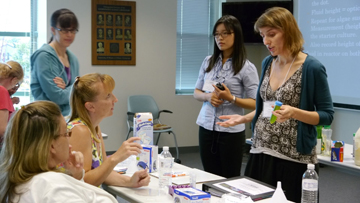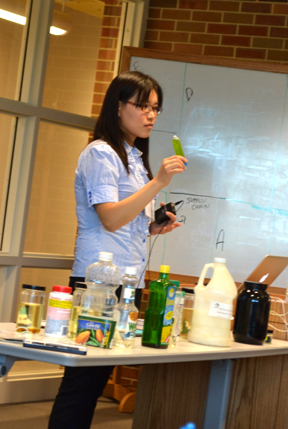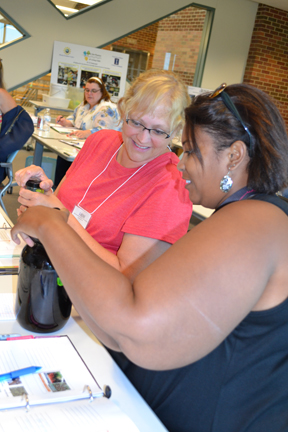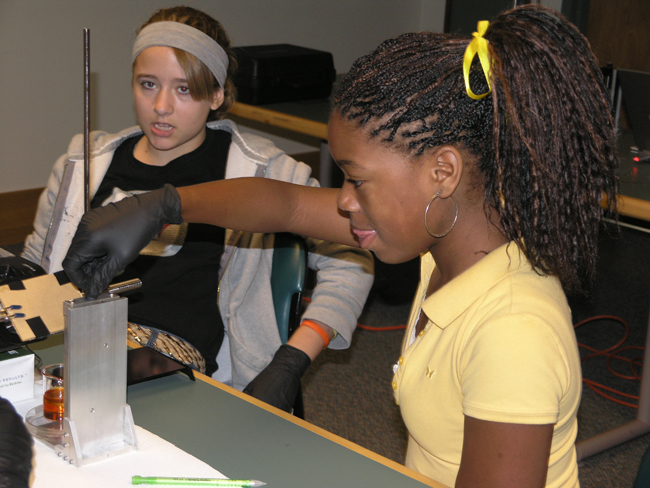iRISE and Denos Work to Get Students Hooked on Science in Middle School

Sharlene Denos (right) discusses lesson plan with teachers during iRISE professional development. Also helping with the professional development are Barbara Hug standing on the (left) and grad student Yan Zhou (standing, in the center). Photograph courtesy Andrew Stengele.
July 31, 2012
One of Sharlene Denos' passions is to expose middle school students to hands-on activities in order to pique their interest in science so it becomes a life-long interest—possibly even a career. Denos hopes to give today's middle school student opportunities she didn't have at that age.
"I never had an opportunity to do any of these things when I was in school. I never once met a scientist or an engineer before I came to the university. We have a real inquiry-based, hands-on focus to all of the lessons that we develop, and that's also something that I didn't have the benefit of. The schools I went to weren't that great…In middle school I didn't do one single lab, ever, in my entire time there."
It was this passion to change the way science is taught to K–12 students that brought her to her current position as the K–12 Education Coordinator at the Center for the Physics of Living Cells (CPLC) and the Director for iRISE (Illinois Researchers in Partnership with K–12 Science Educators).
As a grad student, Denos was an NSF GK-12 Fellow. In this National Science Foundation program, the Fellow is paired up with a local teacher, and they develop curriculum and teach together. She found it really meaningful, and this experience served as the basis for the iRISE program's current emphasis on three audiences: graduate students, middle school teachers, and middle school students themselves.
Involvement of graduate students is through the Physics 598SE course, in which students create hands-on lessons middle school science teachers can use with their students. Denos says it "really does build on their ability to develop curriculum and also their teaching skills." In a nutshell, she calls it "a chance for them to develop a complete lab or lesson from scratch." She indicates that while some grad students get lots of chances to teach undergraduates, others don't.

iRISE graduate student Yan Zhou of Agricultural and Biological Engineering presents her lesson on algae during the summer workshop.
Further, according to Denos, teaching college students is different from teaching younger students: "The kind of teaching that you do with undergrads is: you sort of warn them of what they have to learn, and then they just sort of go and learn it. But with the younger students, you really have to be skilled. It takes a lot of skill to be able to communicate these very complex ideas to middle school students. So it really helps with their communication skills."
She also reports that it prepares graduate students to reduce complex research to terms a layperson can understand…or a seventh grader:
"People often say that if you're writing something for the general public, you should aim for an eighth grade level in terms of reading, and scientific understanding…maybe even less than that. So in a way, this is a program that trains future scientists to communicate really well with the public. Because if they can communicate their research to a seventh-grader, then they can communicate it to the general public, who is in charge of whether or not they get funded to do their research. So it's really, really crucial for scientists that they have this skill to explain to the public, 'Ok, here's what I'm doing, and this is why it's important.'"

Teachers enjoy hands-on activity during iRISE 2012 summer workshop on the Illinois campus.
iRISE also has several mechanisms for working with middle school teachers. For instance, in this past summer's iRISE teacher workshop, Physics 598SE students shared with participants the lessons they had developed. During the workshop, the teachers themselves tried out hands-on activities they could later use with their middle school students.
How are these lessons beneficial to teachers? According to Denos, "They tie the curriculum together with current research in science and engineering and with important social issues. If there's something that people are talking about a lot in the news, the graduate students will pull from that and turn that into a lesson, and talk about the science behind it."

Two teachers at the iRISE workshop prepare to smell a rather putrid-smelling product made from algae.
Some of the relevant lessons offered in this summer's workshop included: "Wind Turbine Design," "Carbon Cycle and Bioreactor Design Competition," "Asteroid Impacts," and "Representational Color in Astronomical Images."
In addition to designing lessons teachers can use with their students, iRISE works with the students directly. For example, in May 2012, Edison Middle School AVID (Advancement Via Individual Determination) students who had been involved in iRISE science enrichment activities this past spring visited campus. During the field trip, students took part in hands-on lessons taught by iRISE/CPLC graduate students, as well as Joe Muskin and Matthew Alonso from NanoCEMMS (Center for Nanoscale Chemical-Electrical-Mechanical Manufacturing Systems).
Why the focus on middle school? Denos considers it to be a crucial age, based on research from a 2006 science paper, Planning Early for Careers in Science. She says the report indicated that "a middle school student with a strong science interest (as measured by their indication of whether they expect to have a career in science) and an average test score is more likely to end up with a STEM degree than one with high test scores and low interest. Getting students interested—getting them hooked at this age is absolutely crucial."
Author/Photographer: Elizabeth Innes, Communications Specialist, I-STEM Education Initiative

Edison Middle School AVID student lowering the stage during a lesson NanoCEMMS' Matthew Alonso presented on rapid prototyping (3D printing) in May 2012.













.jpg)
















